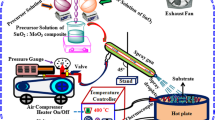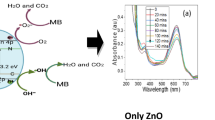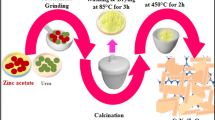Abstract
A series of urchin-like CdS/ZrO2 nanocomposites with different mole ratios of Cd/Zr were prepared by a two-step method combining the microwave-assisted hydrothermal and ion exchange methods. The products were characterized by X-ray diffraction, ultraviolet–visible diffuse reflectance spectroscopy, X-ray photoelectron spectroscopy, scanning electron microscopy, and N2 adsorption–desorption measurements. The results of the study revealed that the CdS/ZrO2 nanocomposites had mixed phases of tetragonal ZrO2 and hexagonal CdS. Moreover, the samples prepared by the microwave-assisted hydrothermal method possessed the urchin-like structure with a surface composed of protrude-like nanoparticles in large quantities. The absorption in the visible region changed slightly with increasing mole ratio of Cd/Zr. Moreover, compared to the nanocomposites prepared by the conventional heating, the nanocomposites prepared by the microwave-assisted hydrothermal synthesis showed significantly different Brunauer–Emmett–Teller values, and the urchin-like CdS/ZrO2 structures were obtained. The photocatalytic degradation of methyl orange under ultraviolet (UV) light irradiation indicated that the photocatalytic activity of the CdS/ZrO2 nanocomposite with CdS/ZrO2 molar ratio of 30 % was higher than those of CdS, ZrO2, and other different ratios of CdS/ZrO2 nanocomposites. Moreover, under UV light, visible light, and microwave-assisted multimode photocatalytic degradation, the urchin-like CdS/ZrO2 nanocomposites significantly affected the photodegradation of various dyes. To understand the possible reaction mechanism of the photocatalysis by the CdS/ZrO2 nanocomposites, a series of controlled experiments were performed, and the stability and reusability of the CdS/ZrO2 nanocomposites were further investigated by the photocatalytic reaction.












Similar content being viewed by others
References
Anderson D, Ciminelli VST (2003) Electroceramic materials of tailored phase and morphology by hydrothermal technology. Chem Mater 15:1344–1352
Asit BP, Garry G, El-Shall MS (2006) Microwave synthesis of highly aligned ultra narrow semiconductor rods and wires. J Am Chem Soc 128:2790–2791
Bai SL, Li HY, Guan YJ, Jiang ST (2011) The enhanced photocatalytic activity of CdS/TiO2 nanocomposites by controlling CdS dispersion on TiO2 nanotubes. Appl Surf Sci 257:6406–6409
Bang JH, Suh WH, Suslick KS (2008) Quantum dots from chemical aerosol flow synthesis: preparation, characterization, and cellular imaging. Chem Mater 20:4033–4038
Belzig W (2006) Device physics: Super-semiconducting nanowires. Nature Nanotech 1:167–168
Benito P, Herrero M, Barriga C, Labajos FM, Rives V (2008) Microwave-assisted homogeneous precipitation of hydrotalcites by urea hydrolysis. Inorg Chem 47:5453–5463
Chen KF, Noh YD, Li KY, Komarneni S, Xue DF (2013) Microwave-hydrothermal crystallization of polymorphic MnO2 for electrochemical energy storage. J Phys Chem C 117:10770–10779
Dedryve` re R, Leroy S, Martinez H, Blanchard F, Lemordant D, Gonbeau D (2006) XPS valence characterization of lithium salts as a tool to study electrode/electrolyte interfaces of Li-ion batteries. J Phys Chem B 110:12986–12992
Ding X, Zhao K, Zhang LZ (2014) Enhanced photocatalytic removal of sodium pentachlorophenate with self-doped Bi2WO6 under visible light by generating more superoxide ions. Environ Sci Technol 48:5823–5831
Fang Z, Liu YF, Fan YT, Ni YH, Wei XW, Tang KB, Shen JM, Chen Y (2011) Epitaxial growth of CdS nanoparticle on Bi2S3 nanowire and photocatalytic application of the heterostructure. J Phys Chem C 115:13968–13976
Gaskell KJ, Starace A, Langell MA (2007) Zn x Ni1−x O rocksalt oxide surfaces: novel environment for Zn2+ and its effect on the NiO band structure. J Phys Chem C 111:13912–13921
Guo DL, Hua H, Yang Q, Li XY, Hu CG (2014) Magnetism in dopant-free hexagonal CdS nanorods: experiments and first-principles analysis. J Phys Chem C 118:11426–11431
Higashimoto S, Kawamoto K, Hirai H, Azuma M, Ebrahimi A, Matsuoka M, Takahashi M (2012) Fabrication of CdS nanotubes assisted by the template-free electrochemical synthesis method and their photo-electrochemical application. Electrochem Commun 20:36–39
Huang Y, Zheng Z, Ai ZH, Zhang LZ, Fan XX, Zou ZH (2006) Core–shell microspherical Ti1−x Zr x O2 solid solution directly from ultrasonic spray pyrolysis. J Phys Chem B 110:19323–19328
Jiang LC, Zhang WD, Yu YX, Wang J (2011) Preparation and charge transfer properties of carbon nanotubes supported CdS/ZnO-NWs shell/core heterojunction. Electrochem Commun 13:627–630
Klauk H (2008) Nanowires’ display of potential. Nature 451:533–534
Kung SC, Xing WD, Veer W, Yang F, Donavan KC, Cheng M, Hemminger JC, Penner RM (2011) Tunable photoconduction sensitivity and bandwidth for lithographically patterned nanocrystal line cadmium selenide nanowires. ACS Nano 5:7627–7639
Li YX, Hu YF, Peng SQ, Lu GX, Li SB (2009) Synthesis of CdS nanorods by an ethylenediamine assisted hydrothermal method for photocatalytic hydrogen evolution. J Phys Chem C 113:9352–9358
Li ZL, Wnetrzak R, Kwapinski W, Leahy JJ (2012) Synthesis and characterization of sulfated TiO2 nanorods and ZrO2/TiO2 nanocomposites for the esterification of biobased organic acid. ACS Appl Mater Interfaces 4:4499–4505
Liang JH, Deng ZX, Jiang X, Li FL, Li YD (2002) Photoluminescence of tetragonal ZrO2 nanoparticles synthesized by microwave irradiation. Inorg Chem 41:3602–3604
Liu SQ, Zhang N, Tang ZR, Xu YJ (2012) Synthesis of one-dimensional CdS@TiO2 core–shell nanocomposites photocatalyst for selective redox: the dual role of TiO2 shell. ACS Appl Mater Interfaces 4:6378–6385
Liu SQ, Chen Z, Zhang N, Tang ZR, Xu YJ (2013) An efficient self-assembly of CdS nanowires-reduced graphene oxide nanocomposites for selective reduction of nitro organics under visible light irradiation. J Phys Chem C 117:8251–8261
Mariscal R, Lopez GM, Fierro JLG, Sotelo JL, Martos C, Grieke NV (2000) Morphology and surface properties of titania–silica hydrophobic xerogels. Langmuir 16:9460–9467
Murugesan S, Akkineni A, Chou BP, Glaz MS, Vanden Bout DA, Stevenson KJ (2013) Room temperature electrodeposition of molybdenum sulfide for catalytic and photoluminescence applications. ACS Nano 7:8199–8205
Nagai M, Irisawa A, Omi S (1998) XPS study of the deactivation and sulfiding of nitrided molybdena-alumina catalyst during the hydrodesulfurization of dibenzothiophene. J Phys Chem B 102:7619–7626
Nam KT, Kim DW, Yoo PJ, Chiang CY, Meethong N, Hammond PT, Chiang YM, Belcher AM (2006) Virus-enabled synthesis and assembly of nanowires for lithium ion battery electrodes. Science 312:885–888
Park JH, Yoo YB, Lee KH, Jang WS, Oh JY, Chae SS, Baik HK (2013) Low-temperature, high-performance solution-processed thin-film transistors with peroxo-zirconium oxide dielectric. ACS Appl Mater Interfaces 5:410–417
Qi C, Zhu YJ, Chen F (2014) Microwave hydrothermal transformation of amorphous calcium carbonate nanospheres and application in protein adsorption. ACS Appl Mater Interfaces 6:4310–4320
Qu XS, Song HW, Bai X, Pan GH, Dong B, Zhao HF, Wang F, Qin RF (2008) Preparation and upconversion luminescence of three-dimensionally ordered macroporous ZrO2: Er3+, Yb3+. Inorg Chem 47:9654–9659
Siedl N, Elser MJ, Halwax E, Bernardi J, Diwald O (2009) When fewer photons do more: a comparative O2 photoadsorption study on vapor-deposited TiO2 and ZrO2 nanocrystal ensembles. J Phys Chem C 113:9175–9181
Silvestre-Albero AM, Jua`rez-Galán JM, Silvestre-Albero J, Guez-Reinoso FR (2012) Low-pressure hysteresis in adsorption: an artifact? J Phys Chem C 116:16652–16655
Sneha P, Parag AD, Giridhar M (2011) Photocatalytic activity of combustion synthesized ZrO2 and ZrO2–TiO2 mixed oxides. Ind Eng Chem Res 50:12915–12924
Sun XW, Huang JZ, Wang JX, Xu Z (2008) A ZnO nanorod inorganic/organic heterostructure light-emitting diode emitting at 342 nm. Nano Lett 8:1219–1223
Tang ZR, Yin X, Zhang YH, Xu YJ (2013) Synthesis of titanate nanotube–CdS nanocomposites with enhanced visible light photocatalytic activity. Inorg Chem 52:11758–11766
Tom RT, Nair AS, Singh N, Aslam M, Nagendra CL, Philip R, Vijayamohanan K, Pradeep T (2003) Freely dispersible Au@TiO2, Au@ZrO2, Ag@TiO2, and Ag@ZrO2 core-shell nanoparticles: one-step synthesis, characterization, spectroscopy, and optical limiting properties. Langmuir 19:3439–3445
Varughese B, Chellamma S, Lieberman M (2002) XPS study of self-assembly of ruthenium dimmers [((acac)2Ru)2bptz+ on hydrophobic and hydrophilic sams. Langmuir 18:7964–7970
Wang XC, Yu J, Chen YL, Wu L, Fu XZ (2006) ZrO2-modified mesoporous nanocrystalline TiO2–xN x as efficient visible light photocatalysts. Environ Sci Technol 40:2369–2374
Wang XJ, Yang WY, Li FT, Xue YB, Liu RH, Hao YJ (2013) In situ microwave-assisted synthesis of porous N–TiO2/g–C3N4 heterojunctions with enhanced visible-light photocatalytic properties. Ind Eng Chem Res 52:17140–17150
Wilson GJ, Matijasevich AS, Mitchell DRG, Schulz JC, Will GD (2006) Modification of TiO2 for enhanced surface properties: finite Ostwald ripening by a microwave hydrothermal process. Langmuir 22:2016–2027
Yin YX, Jin ZG, Hou F (2007) Enhanced solar water-splitting efficiency using core/sheath heterostructure CdS/TiO2 nanotube arrays. Nanotechnology 18:495608–495700
Yoon M, Seo M, Jeong C, Jang JH, Jeon KS (2005) Synthesis of liposome-templated titania nanodisks: optical properties and photocatalytic activities. Chem Mater 17:6069–6079
You LJ, Xu S, Ma WF, Li D, Zhang YT, Guo J, Hu JJ, Wang CC (2012) Ultrafast hydrothermal synthesis of high quality magnetic core phenol–formaldehyde shell composite microspheres using the microwave method. Langmuir 28:10565–10572
Zhang Z, Wang L, Kou SX, Lee YI, Hao JC, Liu HG (2012) One-step synthesis and assembly of one-dimensional parallel chains of CdS nanoparticles at the air-water interface templated by 10,12-pentacosadiynoic acid supermolecules. J Colloid Interface Sci 375:118–124
Acknowledgments
The project was supported by the National Natural Science Foundation of China (21376126), Natural Science Foundation of Heilongjiang Province, China (B201106), Scientific Research of Heilongjiang Province Education Department, China (12511592), Government of Heilongjiang Province Postdoctoral Grants, China (LBH-Z11108), Open Project of Green Chemical Technology Key of Laboratory of Heilongjiang Province College, China (2013 year) and Postdoctoral Researchers in Heilongjiang Province of China Research Initiation Grant Project (LBH-Q13172).
Author information
Authors and Affiliations
Corresponding author
Rights and permissions
About this article
Cite this article
Li, L., Wang, L., Zhang, W. et al. Urchin-like CdS/ZrO2 nanocomposite prepared by microwave-assisted hydrothermal combined with ion-exchange and its multimode photocatalytic activity. J Nanopart Res 16, 2753 (2014). https://doi.org/10.1007/s11051-014-2753-z
Received:
Accepted:
Published:
DOI: https://doi.org/10.1007/s11051-014-2753-z




